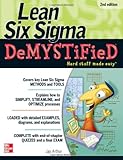Lean Six Sigma Demystified, Second Edition
Your LEAN and mean guide to Lean Six Sigma Ready to implement better, faster, cheaper, more-profitable processes in your organization? Lean Six Sigma Demystified, Second Edition, shows you how to use proven techniques for simplifying, streamlining, and optimizing business practices for maximum productivity and profitability. Written in a step-by-step format, this practical guide covers the fundamental methods and tools of Lean Six Sigma. You’ll get details on reducing defects and deviation, sustaining improvements, and achieving laser-focused process innovations. Measurement systems analysis (MSA), Design for Lean Six Sigma, and statistical tools such as analysis of variance (ANOVA) are also discussed. Clear examples, helpful diagrams, and concise explanations make it easy to understand the material, and end-of-chapter quizzes and a final exam reinforce key concepts. It’s a no-brainer! You’ll learn about: The seven speed bumps of Lean Value stream mapping and
List Price: $ 22.00
Price: $ 10.34
Check This:
 The Six Sigma Way: How GE, Motorola, and Other Top Companies are Honing Their Performance
The Six Sigma Way: How GE, Motorola, and Other Top Companies are Honing Their PerformanceThis title is an implementation blueprint for Six Sigma! “”The Six Sigma Way” demystifies Six Sigma with a real-world ‘how-to ‘gui…
 Lean Six Sigma For Dummies
Lean Six Sigma For DummiesWith the growing business industry there is a large demand for greater speed and quality, for projects of all natures in both smal…



Well worth the price.,
As a member of a team implementing lean and six sigma I researched many books before settling on this one. The first two chapters are worth the price of the whole book. If you aren’t fired up and ready to go after reading them then you just don’t care about your job. My only problem with the book is that the author uses it to push his Excel software for data analysis. This wouldn’t be such a big deal, except it’s done to the detriment of actually explaining the math and the basics underlying the charts. But, if you really want to know what the software is doing, you can look up the various charts on the internet and get good explanations for free. Between doing that and reading this book you’ll come out with a good understanding of the concepts needed to implement lean and six sigma.
Was this review helpful to you?

|Successful implementation made easy,
“Lean Six-Sigma” sounds so exotic. And complex. In reality, it is a simple methodology. The perceived complexity seems to come from our expectations. People see a typical Six-Sigma book, and note that it contains a few Summation or Integral notations, and wig-out. Well, they say, this is beyond my level. And move on.
Pity. As an almost math major at university (my BS is actually in General Studies so I could get credit for classes in a misguided attempt to become an architect), the notation did not scare me. However, I had little idea how to apply the concepts to business problems in a meaningful way.
After reading this book, I looked at efficiencies in our office with new eyes. Using the free trial of Arthur’s Excel macros that came with the Kindle download, I made some subtle improvements to the satellite office I run. This was completed without corporate or IT involvement, solely by myself and a small leadership team.
Below are the results I can track to this approach over the past 3 or 4 months three month’s work.
1)Moved printers, fax machines and supplies to locations that were, in essence, centrally located. Productivity, measure in customer contacts soared 25%. Revenue up 10% versus the enterprise average (including us).
2)Stored frequently updated documents in a centralized, cloud-based location. Minimizing search time.
3)Starting with a static document for a key process, responsible for 7-12% of our revenue depending on the month, translated it into HTML/JavaScript driven document. This integrated data, emails and web-pages directly into one document. The JavaScript would only reveal the “next step” and necessary data based on the issue and a rep’s prior selection. The interface was very intuitive, and reps adopted it immediately. Result: the mean time in completing the tasks dropped about 75%, while errors plummeted almost 100%–from over 170 transactions containing an error, many of them multiple, to about 2 per month.
4)Worked out an account management system, based on Pareto’s 80/20 rule, using fish-bone diagrams and “5 why’s” .
I would never have been able to do this without Arthur’s simple, pragmatic approach. I could understand the notation presented in other Six-Sigma and SPC books due to my training. But how to apply them? Especially in a corporate system, lean on resources due to a tight economy without up-line support due to revenue pressures.
Best analogy I can come up with was how I learned Spanish in university. Before Arthur, I knew the language. But could not speak to locals. Now, I not only understand the grammar and vocabulary, but can speak meaningfully with the locals, using colorful idioms.
Was this review helpful to you?

|